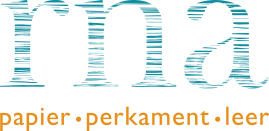The restoration and conservation of herbaria in three phases
During the first phase, 25 Japanese book herbaria restored. Philipp Franz von Siebold (1796-1866) she received during his stay at Deshima in Japan between 1823 and 1830 from his Japanese colleagues and students. The herbaria mark the start of the modern European botany in Japan. Such objects are only in the National Herbarium still present and are therefore important research material for those who want to study the flora of Japan or the relationship between Japanese scientists and the Dutch on Deshima.
The Leiden branch of the National Herbarium of the Netherlands (NHN), formerly the Rijksherbarium, houses many important botanical collections. One of these is a 19th century collection of Japanese plants, generally referred to as the “Siebold” collection. The plants belonging to this collection were gathered during a period in which Japan was still closed to all western nations except the Netherlands. A considerable number of the ca. 12,000 specimens, which include phanerogams as well as cryptogams, were brought together by the famous German physician P.F. von Siebold (1796-1866). In 1823 the Government of the Dutch East Indies sent him to Japan as the physician of the factory on Deshima, an artificial island in the Bay of Nagasaki. He also had the task of collecting information about the various aspects of Japan.
Von Siebold thought himself very lucky to go to Japan. Almost nothing new had been learned about the Japanese flora since the publication of Thunberg’s Flora Japonica in 1784. For Von Siebold this meant that there were many opportunities to make new discoveries. Even before he arrived on Deshima, he planned to describe the fauna and flora of Japan as completely as possible and to collect all the species to be found there. In 1823 he wrote that he would not leave Japan before he had collected all the material needed for the preparation of a Flora Japonica (Schmid,1942).*
The plants are put in different ways fixed on the pages. By bending the blades when turning plant material is loosened and broken down. We have managed to reduce this loose plant material back to its original place. By now implemented conservation, all these unique herbaria again for both scientific botanical research and exhibition purposes available.
The actions carried out are dry cleaning, securing plants and plant residues, cut pieces from pages restore and strengthen bindings.
In almost all parts of the Keiske Ito series are blades cut loose with a knife. Often through a few pages back cut which partially or completely loose. These pages are put fixed with a strip of Japanese paper and starch.
From the parts of the Kaiso series in the past, many plants have been removed, by supplementing it with paper and cut already off. This makes the book block had become very unstable, especially when turning the pages. All pieces cut again ingestukt with tailored Japanese paper and put firmly with starch.
The second stage
In the second phase, 11 books treated and contained in boxes. Among these books were part of the two-part 17th-century herbarium with Ceylonese planting the VOC physician P. Hermann, the only herbarium in the Netherlands with a relationship to the VOC. There was one more piece herbarium of the 18th century army doctor d’Oignies between. The plants in the herbarium are mounted in engravings of vases. The herbaria are again consulted for scientific research and can be exhibited.
Many books in the National Herbarium have been treated in the past with mercury chloride to prevent insect damage and mildew. TNO has performed measurements in the workshop and there is no measurable mercury evaporation.
The books are gedroogreinigd. Leather caps, ripped off hinges, naaisel and magazines restored. Individual plant parts are put fixed with starch, mixlijm (reversible EVAc and methyl cellulose), or gelatine, and in some cases are not back-slice-out leaf residues inserted in small envelopes.
The third and final phase
In the last phase it was possible oldest existing herbarium in the world, the so-called. And tibi herbarium restored. The 16th century herbaria of the German physician Rauwolff and 17th century herbaria of Leiden pharmacist Gaaymans with plants from the Leiden Hortus was restored. The latter herbarium has played a major role in the reconstruction of the Clusius Garden in Leiden. In addition there are herbaria with grasses and lichens, and the oldest herbarium with plants treated in Suriname.
The books are cleaned with soot sponge and brush and loose plant parts are firmly put. Loose plant remains which could not be determined where they needed to be replaced are placed between handmade paper and stored at the site.
Broken pages are repaired with Japanese paper and donkey ears are flattened. Of the tires where necessary restore the structure. Cracks and holes in the cover band are complemented by leather and Japanese paper.
All herbaria be stowed in customized handling cardboard boxes of conservation (Pyxis of Schrijen bookbinders) or linen-lined boxes of throughput (Beautiful Books, Pau Groenendijk). This makes the books are protected against dust and are more controllable. The boxes also hold somewhat against climate change. Of any materials and consumables name, recipe and supplier in a report.
* Taken from G. Thijsse “The Siebold Herbarium” 2004
